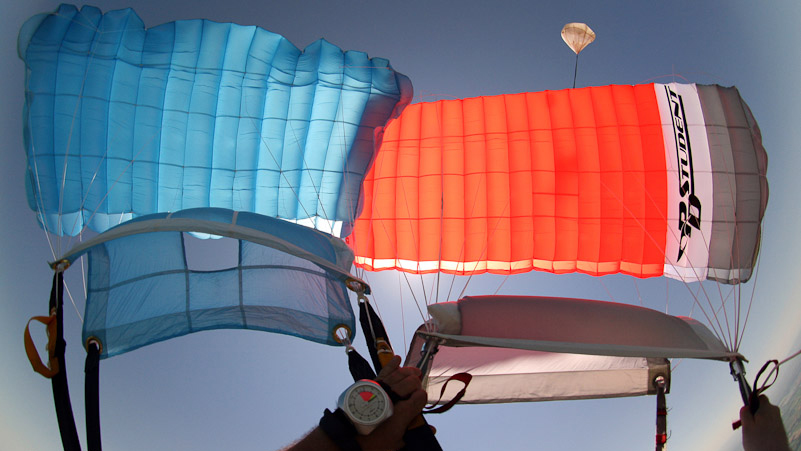Deciding on an activation altitude for your AAD is a big decision

Here are what some experienced professionals in our sport have to say about their altitudes and what influenced that decision
For most of us, at some point we’ll find ourselves in a malfunction that requires some very important, quick decision-making. The time we take on the ground to rehearse our EPs, consider and set our hard decks, think about and work out various scenarios and solutions and set our AADs to our chosen altitude is how we can be as prepared as possible for when that malfunction arises.
The two most widely used AADs worldwide come with a standard firing altitude for experienced jumpers as follows, according to the relevant manufacturer manuals:
CYPRES – An Expert CYPRES activates at approximately 750 feet Above Ground Level (AGL) if the rate of descent is more than 78 mph.
Vigil – in PRO mode activates between 840 ft and 1,100 ft AGL (depending on body position), if the descent rate is 78mph or more.
You may, or may not, be aware that this altitude can be changed to accommodate your personal desire for activation altitude.
But how do you decide what to set that activation to?
There are many factors to consider. First and foremost, how much time do you need and want under your reserve? How much time do you need in the case of line twists under your reserve? Are you jumping over terrain where you may need extra time to avoid obstacles? These are just a few factors to be considered.
We asked several leaders in our sport what activation they have their AAD set to and how they made that decision. There is no right or wrong answer to this question, one has to think it out for oneself.
Luis Adolfo Lopez-Mendez

When Cypres came out, canopies, vertical flying speeds and wing loadings were a lot lower, and reserves were bigger. I have my Cypres activation set to +200 feet. This altitude will give me more time to assess for alternate landing areas or clear any twist in my reserve. At 750 feet you barely have time to grab the reserve toggles and look for a landing area. If you choose to increase your Cypres activation altitude, you should also consider to increase your hard deck altitude in your audibles and also increase your deployment altitude in the same proportion you did on your AAD. As an example I have increased my hard deck to 1,700 feet and deployment altitude by 200 feet. You are responsible to know your equipment and locations you are jumping (elevation, gear, etc) to make a responsible choice when thinking of changing your AAD activation altitude.
Luis Adolfo Lopez-Mendez, Fly Warriors
Amber Forte

Espen Fadnes and I decided to adjust the height on our Vigil AADs by 300 feet to increase our safety margins. This is especially important in Norway where we often skydive in areas with altitude differences in close proximity to the dropzone.
Amber Forte, Wingsuit World Medalist
Luis Prinetto

Years ago I saw a reserve deployment from an AAD activation, leaving the skydiver with a fully open reserve at just over 100 feet. I thought that was too low which made me bump mine up 200 feet above the Cypres factory setting.
Luis Prinetto, Founding Member of Team Fly4Life
Dan BC

My Vigil is set for 1,050 feet. When I was making this choice I considered a few things:
1. 840 feet is the ‘last hope’ altitude. It’s high enough to get a reserve over your head in perfect conditions. But if there is any deployment delay such as a pack opening or pilot chute hesitation it might not be high enough to save you. It also doesn’t give you much time to avoid obstacles, land into the wind and land softly.
2. An additional 200 feet would give enough time in case of a deployment delay to still get a good reserve over your head. If you have a good reserve opening it gives you some time to avoid obstacles, face into the wind and land safely.
3. If your AAD is set higher and you were to lose altitude awareness, initiate deployment too low, have a hard pull or have a pilot chute in tow you are more likely to have an AAD fire and a two out situation.
I asked myself, what is the right altitude to set my AAD which is high enough to get a good reserve over my head even with a deployment delay and gives me an important extra few seconds to land safely, but low enough to minimize the possibility of a two out if I’m an idiot and end up too low? 1,050 feet seemed like the best compromise.
Dan BC, World Champion and Record Organizer
Mason Corby

I’ve configured my Cypres to 750ft to match my high-performance canopy and turn initiation altitude. In group jumps, I stay alert for collisions, treating every jumper and canopy as potential risks, and advocating the same vigilance among peers. I prioritise equipment maintenance, advice-seeking, and active practice of malfunction procedures. I’ve refined my cutaway process, focusing on composure and altitude awareness in emergencies. While my AAD is a safeguard, I don’t rely solely on it—like a car’s airbag, it’s there if needed. With a larger reserve canopy for emergencies, I strive to avoid low-altitude situations, trusting my ability to act quickly in fast evolving situations with a cool head.
Mason Corby, Coach and Founder, Downunder Dynamics
Anna Moxnes

Your AAD is designed to fire a cutter with the intention of cutting a reserve closing loop. It does not open your reserve. Even after the AAD has successfully fired, your entire reserve deployment needs to take place. Adding extra feet is adding extra safety margin, until of course it is not. So your decisions need to be in line with your choice of main parachute and your deployment altitude and cutaway hard deck. I have added 150 feet to my Vigil.
Anna Moxnes, Coach, Joyriders Founding Member
Lesley Gale

I chose to reset my firing altitude permanently to 950 feet. I think it’s a logical choice for how the sport and our equipment have changed. I bought a Cypres AAD over 30 years ago, when it was launched in 1991. At that time, we tracked off from an 8-way at around 3,500 feet and deployed around 2,000 feet. Now, like most belly flyers I track off at 5,000 and deploy around 3,000 feet. I still have a healthy margin of over 2,000 feet between intended main deployment height and AAD activation of the reserve. My chances of a 2-canopy scenario are lower than originally.
Having a reserve over your head does not necessarily keep you uninjured. I want a little more time to prepare for landing, especially on an unfamiliar canopy. My higher activation altitude gives a little more time in case of any issues with the reserve opening, or if I am over some higher terrain, and to choose a landing area.
Lesley Gale, Big-way Record Coach, Skydive Mag Founder
Matt Gerdes

My Vigil is set to +150 feet for all jumps. After speaking with Willy Boeykens of Vigil about how AADs take samples, and how wingsuits can spin or tumble through the firing altitude and how the AAD can ‘miss’ readings due to pressure changes, it became clear to me that 840 feet is too low.
Matt Gerdes, CEO, Squirrel Wingsuits
Carmen Hübner

I myself have not changed from the standard settings. I open my canopy at about 1,000 meters (3,200 feet) normally. I believe that’s high enough to compensate for whatever happens. After consulting with the manufacturer of my harness, I know there is no delay in the reserve opening. I feel safe with my emergency procedures and am OK with an approx 225 meters opening with Cypres. The dropzones I jump at, there are no mountains/valleys in close range that would justify a permanent adjustment. If I start from a dropzone that is lower or higher than the one I want to jump from, then I adjust accordingly. In this case, the opening window is offset for a short time. With a permanent height adjustment, the opening window is enlarged.
Carmen Hübner, Customer Service, CYPRES
Karl Meyer

When you raise the activation altitude, always allow enough time to have a fully open main canopy approximately 1,000ft above your new activation altitude. During a slow opening, it may take longer until you have a fully open main canopy, which may bring you closer to the activation altitude you choose.
Karl Meyer, Vigil
Julian Barthel

I have my Cypres set on A2, which is 950 feet, since I want to have time after my reserve opens to choose where I land if I’m conscious. I feel that those extra 200 feet make a lot of sense since there’s already a big firing variance in activation altitude, in even just a belly-to-earth scenario. Realistically if my AAD fires it’s likely that I’m unconscious and unstable. I chose 200 feet higher because above that it starts to majorly impact my decision altitude and as a result, my deployment altitude. I wrote an entire article on this here.
Julian Barthel, Freefly Coach

Manuals
Here are links for the user manuals for both Cypres and Vigil AADs, which have instructions for resetting the firing altitude.
Resetting CYPRES Activation Altitude
If you wish to reset your CYPRES activation altitude permanently, here is a helpful step-by-step video by Axis Flight School:
Video – Resetting CYPRES Activation Altitude
Further Reading

Image by Performance Designs
If you wish to continue reading on this subject, we have a few articles that might be useful as you consider your AAD activation altitude.
Two Canopies Out – Results of test jumps by PD for a PIA report on dealing with a dual square scenario
Why not Reset your Activation Altitude, by Johannes Bergfors
Unusual Emergencies: Dual Deployments, by Jim Cowan, who covers the possible outcomes of two canopies simultaneously deploying, and his recommended action in detail for each knotty problem…
Take care out there.



